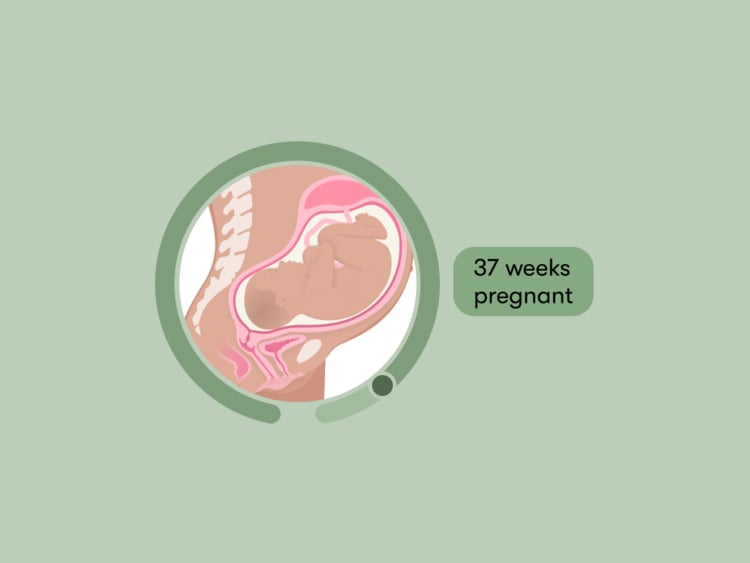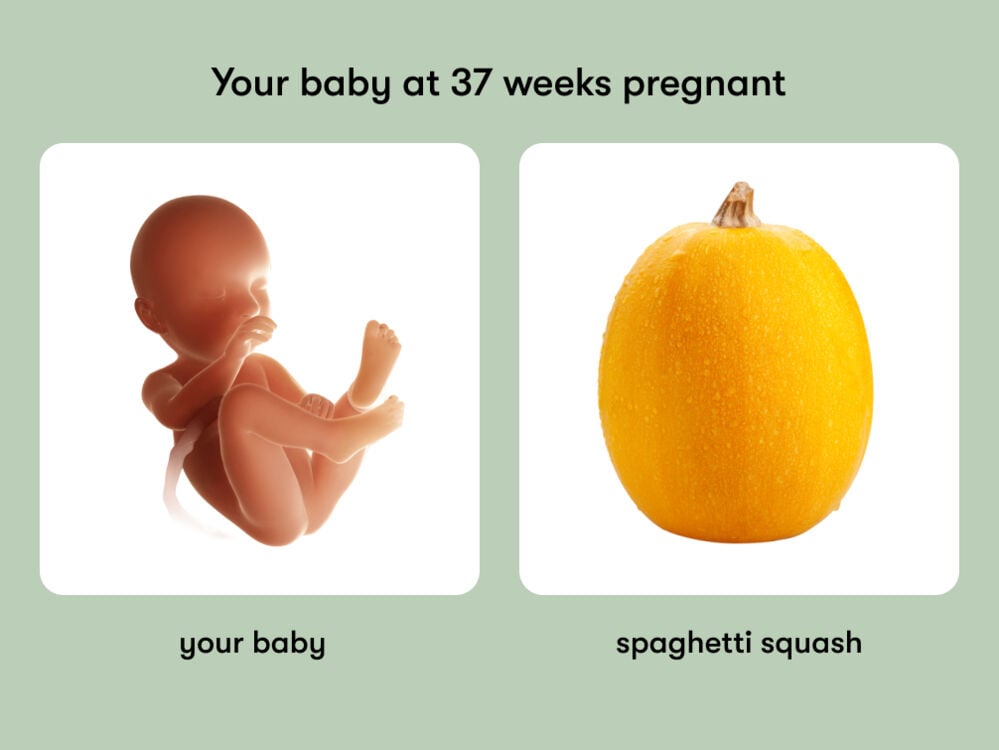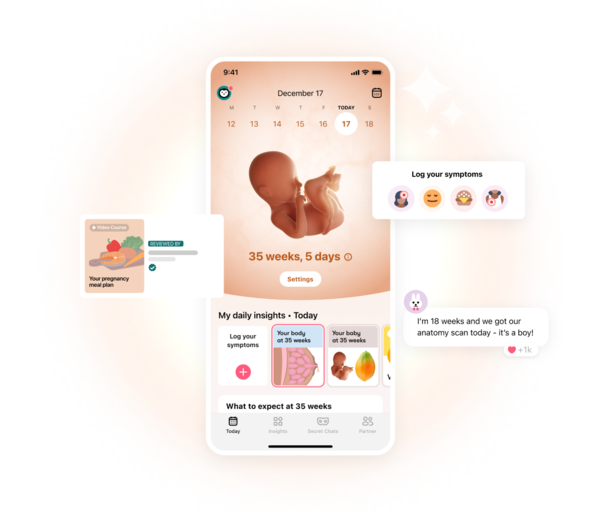From bump changes to possible contractions, here’s the lowdown on being 37 weeks pregnant.
-
Tracking cycle
-
Getting pregnant
-
Pregnancy
-
Help Center
-
Flo for Partners
-
Anonymous Mode
-
Flo app reviews
-
Flo Premium New
-
Secret Chats New
-
Symptom Checker New
-
Your cycle
-
Health 360°
-
Getting pregnant
-
Pregnancy
-
Being a mom
-
LGBTQ+
-
Quizzes
-
Ovulation calculator
-
hCG calculator
-
Pregnancy test calculator
-
Menstrual cycle calculator
-
Period calculator
-
Implantation calculator
-
Pregnancy weeks to months calculator
-
Pregnancy due date calculator
-
IVF and FET due date calculator
-
Due date calculator by ultrasound
-
Medical Affairs
-
Science & Research
-
Pass It On Project New
-
Privacy Portal
-
Press Center
-
Flo Accuracy
-
Careers
-
Contact Us
37 weeks pregnant: Your guide to this week of your third trimester


Every piece of content at Flo Health adheres to the highest editorial standards for language, style, and medical accuracy. To learn what we do to deliver the best health and lifestyle insights to you, check out our content review principles.
There’s no doubt that being 37 weeks pregnant is a special time, with your baby’s arrival likely to be just around the corner. It’s natural to feel anxious as well as excited this week, with lots of things to think about and prepare for ahead of your due date.
Our guide on labor and delivery tips can help you feel ready for what’s coming next. But to help you feel aware of everything happening this week, we’ve gathered the key information below, including advice from a Flo expert.
Your baby at 37 weeks pregnant
Almost ready to be born
At 37 weeks, your baby has reached early term. They’re just two weeks away from being full term, which starts at 39 weeks — so soon! Forty weeks marks their due date, but one study found only 5% of babies are actually born on this day.
Practicing smiling
Adorably, this week, your 37-week-old baby is practicing smiling. Right now, their smiles are random and not linked to their emotions. But by the time they’re two months old, they’ll be able to smile (and frown!) on purpose.
How big is a baby at 37 weeks?
Length (crown to heel): 48 cm or 19 in
Weight: 3 kg or 6.7 lb
Size: Equivalent to a spaghetti squash
All measurements are approximate and vary within the normal range.

Your body at 37 weeks pregnant
Bump changes
At 37 weeks pregnant, you might see some new changes to your baby bump. “This is when someone might notice the baby dropping,” says Dr. Jenna Beckham, obstetrician and gynecologist, WakeMed, North Carolina, US.
This process is called lightening. As your baby’s head drops lower into your pelvis (if it’s in the head-down position), it can change the shape of your belly, causing it to “drop.” Lightening is a sign of labor, but it’s worth noting that it can happen from up to a few weeks to a few hours before labor begins. So, if you’ve noticed this change, it doesn’t necessarily mean that you’re about to give birth.
Contractions may occur
There are two types of contractions that can occur at 37 weeks pregnant, as Dr. Beckham explains. “Braxton Hicks contractions, or practice contractions, are not usually painful,” she says. “They are also more often irregular and do not persist.” These can sometimes also be called false labor contractions.
On the other hand, “Labor contractions are more painful and typically occur more frequently and regularly,” says Dr. Beckham. “They also do not go away.”
Confused? We hear you. There’s no doubt that it can sometimes be hard to tell if you’re going into labor. Remember that you can always speak to your health care provider if you’re unsure whether you’re experiencing Braxton Hicks contractions or labor contractions. They’ll be able to help you figure out if it’s time to head to the hospital or not. And if you experience any false alarms, there’s definitely no need to feel embarrassed! It’s always better to be on the safe side.
Your questions answered
Is it okay to deliver at 37 weeks? How likely is it?
It is possible to safely deliver a baby at 37 weeks. At this point, your baby is considered to be early term.
Delivering a baby at 37 weeks has fewer risks of complications than if they were born preterm. While experts advise that it’s best to deliver a baby at full term (from 39 weeks) if possible, remember that a baby born at 37 weeks (for example, spontaneously or for medical reasons) can still do well.
What should I be feeling at 37 weeks?
At 37 weeks pregnant, you’re likely to experience many of the same symptoms as in earlier weeks, such as mood swings and sore or leaky breasts.
Have you found yourself filling up your shopping cart at your favorite websites? There’s a reason for that. Sometimes, women get a new spurt of energy as labor approaches. This is called the nesting instinct, and it might drive you to stock up your fridge and arrange your baby’s crib so that it’s just right for their arrival. However, it’s also perfectly normal not to get a spurt of energy at this point, so don’t worry if you’re feeling the same as you did in previous weeks.
If you’ve experienced lightening, this can sometimes relieve other pregnancy symptoms. With your baby no longer pressing against certain parts of your body, you may experience less heartburn, indigestion, or need to pee. Again, this relief doesn’t come for everyone, so if you’ve still got these symptoms, keep going. You’re nearly there!
How can you tell if labor is days away?
As you approach your due date, it’s perfectly natural to start wondering if every tweak and twinge in your belly is a sign that labor could be days away. But frustratingly, Dr. Beckham says that “there is no reliable predictor of the onset of labor.” And sometimes, it can be hard to know for sure whether you’re in labor or not, as those early signs can be quite subtle.
Aside from contractions and lightening, some other possible signs of labor include:
- Your water breaking: During pregnancy, your baby is cushioned by the amniotic sac, which is a membrane filled with fluid. This membrane will rupture either before or during labor, causing the fluid to come out of your vagina. You may experience this as a trickle or as a gush of fluid. If you’re not sure whether or not your water has broken, always speak to your health care provider.
- An increase in vaginal discharge: Have you heard of the mucus plug? It may sound a bit odd, but it has the important job of blocking bacteria from entering the uterus during pregnancy. At around 37 weeks pregnant, or in the late third trimester, it might pass through your vagina. If this happens, you may notice more discharge. While losing your mucus plug generally means your body is getting ready for labor, it doesn’t indicate how soon other labor symptoms will start — it could be a matter of hours, days, or even weeks.
How do I know I’m dilating?
As your body prepares for labor, your cervix will dilate (or open) to make room for the baby to pass through. Clever, right? You’ll typically need to have a vaginal exam to find out whether you’re dilating or not. Your health care provider will measure the opening of your cervix, which will open to 10 cm or 3.9 inches (yes, really!) when fully dilated.
Take a quiz
Find out what you can do with our Health Assistant
37 weeks pregnant checklist
Get ready for your baby’s arrival
You may have already purchased things like cute baby clothes, a stroller, and a changing mat for your little one. To find out all the things you need to buy before your baby arrives, read our handy newborn essentials checklist.
Another important thing to think about is choosing a health care provider for your baby. Speak to your doctor to find out about the options that are local to you.
Finally, this week can also be a good time to pack your hospital bag if you haven’t already. Check out our list of things to pack for labor to make sure you haven’t forgotten anything.
Do pelvic floor exercises
Your pelvic floor is an important set of muscles that run like a sling from the back to the front of your pelvis. Exercising these muscles can lead to a stronger pelvic floor and could make it less likely you’ll have issues such as stress incontinence or prolapse after your baby’s born.
If these reasons weren’t enough to start doing your exercises, the pelvic floor can also make sex better. In fact, when the muscles are strong, it can lead to more intense orgasms. Sign us up!
You may have started doing pelvic floor exercises already, but just in case, we’ll recap. All you have to do is squeeze and lift the muscles as hard as you can, building up to holding them for 10 seconds at a time.
But, if you’re having any trouble with these, it’s worth asking your health care provider for their advice. They may also be able to refer you to a pelvic floor therapist or an obstetric physiotherapist for extra advice and tips.
While we’re on the subject of your pelvic floor, now is a good time to be working some perineal massage into your daily routine. From 35 weeks pregnant, massaging the area between your vagina and anus can help to prevent tears during labor that require stitches. Ideally, either you or your partner will perform this massage three to four times a week, for five minutes each time.
When to consult a doctor at 37 weeks pregnant
If you think you might be going into labor, you should contact your doctor right away. As we’ve seen, some of the signs that labor can be close include:
- Lightening: Feeling that your baby has dropped lower into your pelvis
- Loss of the mucus plug: Noticing an increase in vaginal discharge. This is caused by your cervix dilating, pushing the mucus plug that’s been protecting it during pregnancy out of your body.
- Your water breaking: Experiencing fluid that either trickles or gushes from your vagina. This is caused by the rupturing of the amniotic sac that’s been surrounding your baby.
- Contractions: Pain in your back or pelvis, caused by your uterus contracting, that happens more regularly over time
Right now, you may be having a checkup with your doctor every week. However, how often you see your doctor will depend on where you live, as well as what you and your doctor decide is right for you and your baby.
You don’t need to wait until your appointments if you have any concerns or questions about your pregnancy. However, at 37 weeks pregnant, you should contact your doctor immediately if you experience:
- Severe cramping
- Vaginal bleeding
- Changes in vaginal discharge
- Fever
- Dizziness and fainting
- Severe vomiting
- Severe headaches or blurry vision
- Intense heartburn
- A decrease in the amount you feel your baby move
This isn’t an exhaustive list and just some examples of the changes you should look for. Some of these can be a sign of health complications, so it’s essential that you speak to your doctor about the best next step for you. And if you’re worried about any other symptoms you experience during pregnancy, don’t hesitate to reach out to your health care provider.
37 weeks pregnant: The takeaway
There’s certainly a lot to be thinking about at 37 weeks pregnant, from signs of labor to preparing for your baby’s arrival. Try not to stress if you feel like you haven’t checked enough things off your to-do list. The most important thing is to make sure you’re feeling as comfortable as possible in these final few weeks. Eventually, everything else will fall into place.


Hey, I'm Anique
I started using Flo app to track my period and ovulation because we wanted to have a baby.


The Flo app helped me learn about my body and spot ovulation signs during our conception journey.


I vividly
remember the day
that we switched
Flo into
Pregnancy Mode — it was
such a special
moment.
Real stories, real results
Learn how the Flo app became an amazing cheerleader for us on our conception journey.
References
“Week 37.” NHS, www.nhs.uk/start-for-life/pregnancy/week-by-week-guide-to-pregnancy/3rd-trimester/week-37/. Accessed 18 July 2023.
“Antenatal Perineal Massage.” Cambridge University Hospitals, www.cuh.nhs.uk/patient-information/antenatal-perineal-massage-explained/. Accessed 18 July 2023.
“Avoidance of Nonmedically Indicated Early-Term Deliveries and Associated Neonatal Morbidities.” The American College of Obstetricians and Gynecologists, Feb. 2019, www.acog.org/clinical/clinical-guidance/committee-opinion/articles/2019/02/avoidance-of-nonmedically-indicated-early-term-deliveries-and-associated-neonatal-morbidities.
“Bleeding during Pregnancy.” The American College of Obstetricians and Gynecologists, May 2021, www.acog.org/womens-health/faqs/bleeding-during-pregnancy.
“Braxton Hicks Contractions.” Cleveland Clinic, my.clevelandclinic.org/health/symptoms/22965-braxton-hicks. Accessed 18 July 2023.
Brubaker, Linda. “Patient Education: Pelvic Floor Muscle Exercises (Beyond the Basics).” UpToDate, 5 May 2023.
“Cervical Effacement and Dilation.” Mayo Clinic, www.mayoclinic.org/healthy-lifestyle/labor-and-delivery/multimedia/cervical-effacement-and-dilation/img-20006991. Accessed 20 July 2023.
“Choose a Doctor for Baby.” Mayo Clinic Health System, www.mayoclinichealthsystem.org/locations/eau-claire/services-and-treatments/birthing-centers/getting-ready-for-baby/choose-a-doctor-for-baby. Accessed 18 July 2023.
Curran, Mark A. “Fetal Development.” Perinatology.com, perinatology.com/Reference/Fetal%20development.htm. Accessed 18 July 2023.
“Definition of Term Pregnancy.” The American College of Obstetricians and Gynecologists, Nov. 2013, www.acog.org/clinical/clinical-guidance/committee-opinion/articles/2013/11/definition-of-term-pregnancy. Accessed 18 July 2023.
“For More Babies, Birth Comes Too Soon.” Stanford Medicine, www.stanfordchildrens.org/en/topic/default?id=for-more-babies-birth-comes-too-soon-1-4090. Accessed 18 July 2023.
Friel, Lara A. “Fevers during Pregnancy.” MSD Manual Consumer Version, Oct. 2021, www.msdmanuals.com/home/women-s-health-issues/pregnancy-complicated-by-disease/fevers-during-pregnancy.
“How to Look after Your Pelvic Floor.” NHS Inform, 25 Jan. 2023, www.nhsinform.scot/ready-steady-baby/pregnancy/looking-after-yourself-and-your-baby/how-to-look-after-your-pelvic-floor.
“How to Tell When Labor Begins.” The American College of Obstetricians and Gynecologists, May 2020, www.acog.org/womens-health/faqs/how-to-tell-when-labor-begins.
“Infant Development: Birth to 3 Months.” Mayo Clinic, 10 Feb. 2023, www.mayoclinic.org/healthy-lifestyle/infant-and-toddler-health/in-depth/infant-development/art-20048012.
“Infant Jaundice.” Mayo Clinic, 6 Jan. 2022, www.mayoclinic.org/diseases-conditions/infant-jaundice/symptoms-causes/syc-20373865.
“Pregnant? Here’s How Often You’ll Likely See Your Doctor.” Cleveland Clinic, 14 Jan. 2022, health.clevelandclinic.org/prenatal-appointment-schedule/.
Khambalia, Amina Z., et al. “Predicting Date of Birth and Examining the Best Time to Date a Pregnancy.” International Journal of Gynaecology and Obstetrics, vol. 123, no. 2, Nov. 2013, pp. 105–09, www.sciencedirect.com/science/article/abs/pii/S0020729213003305.
“Kick Counts.” Cleveland Clinic, my.clevelandclinic.org/health/articles/23497-kick-counts. Accessed 14 June 2023.
“Labor and Delivery.” Cleveland Clinic, my.clevelandclinic.org/health/articles/9676-labor-delivery. Accessed 18 July 2023.
“Morning Sickness: Nausea and Vomiting of Pregnancy.” The American College of Obstetricians and Gynecologists, May 2020, www.acog.org/womens-health/faqs/morning-sickness-nausea-and-vomiting-of-pregnancy.
“Mucus Plug.” Cleveland Clinic, my.clevelandclinic.org/health/symptoms/21606-mucus-plug. Accessed 18 July 2023.
“My Premature Baby’s Development in the Womb: Week 37.” Tommy’s, www.tommys.org/pregnancy-information/premature-birth/my-premature-babys-development-womb-week-37. Accessed 18 July 2023.
"Newborn Jaundice.” NHS, www.nhs.uk/conditions/jaundice-newborn/. Accessed 18 July 2023.
Braatz, Ellen, and Erin Alft. “Pelvic Floor Health for Women.” Association for Pelvic Organ Prolapse Support, www.pelvicorganprolapsesupport.org/pelvic-floor-health-for-women. Accessed 18 July 2023.
“Pregnancy and Birth: When Your Baby’s Due Date Has Passed.” InformedHealth.org, Institute for Quality and Efficiency in Health Care, 22 Mar. 2018,www.ncbi.nlm.nih.gov/books/NBK279571/.
“Heartburn during Pregnancy.” Cleveland Clinic, my.clevelandclinic.org/health/diseases/12011-heartburn-during-pregnancy. Accessed 14 June 2023.
“Preterm Labor.” Mayo Clinic, 8 Feb. 2022, www.mayoclinic.org/diseases-conditions/preterm-labor/symptoms-causes/syc-20376842.
“Vaginal Discharge in Pregnancy.” NHS, www.nhs.uk/pregnancy/related-conditions/common-symptoms/vaginal-discharge/. Accessed 14 June 2023.
“Signs of Labor: Know What to Expect.” Mayo Clinic, www.mayoclinic.org/healthy-lifestyle/labor-and-delivery/in-depth/signs-of-labor/art-20046184. Accessed 20 July 2023.
“Urgent Maternal Warning Signs.” Centers for Disease Control and Prevention, www.cdc.gov/hearher/maternal-warning-signs/index.html. Accessed 20 July 2023.
“What Are Pelvic Floor Exercises?” NHS, www.nhs.uk/common-health-questions/lifestyle/what-are-pelvic-floor-exercises/. Accessed 18 July 2023.
“What You Should Bring.” Mayo Clinic Health System, www.mayoclinichealthsystem.org/locations/eau-claire/services-and-treatments/birthing-centers/getting-ready-for-baby/what-you-should-bring. Accessed 18 July 2023.
History of updates
Current version (08 September 2023)
Published (24 February 2019)
In this article

Get your personal guide to pregnancy with the Flo app
-
Follow your baby's growth week by week
-
Get expert info on symptoms, safe foods, and more
-
Chat with other parents-to-be




